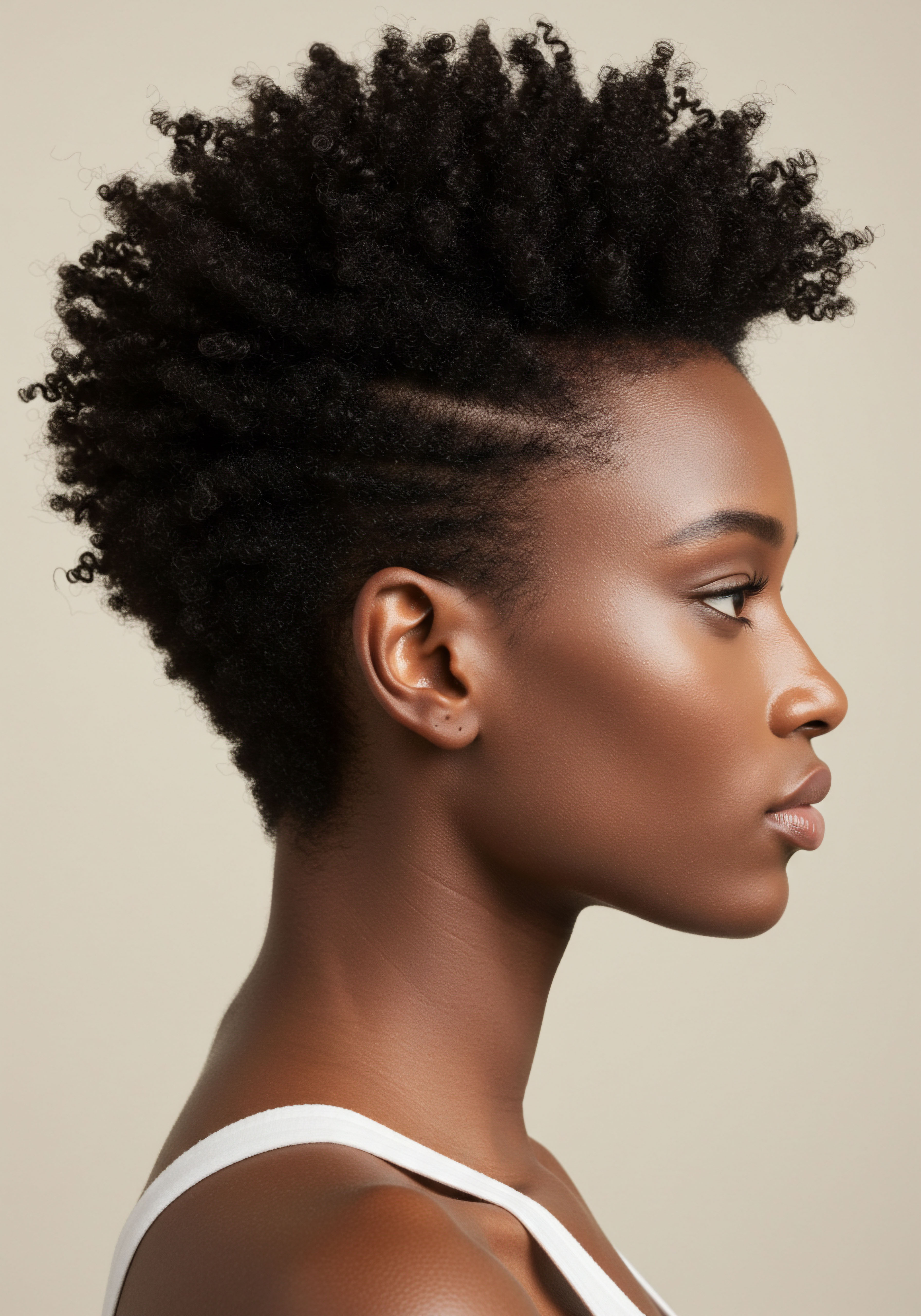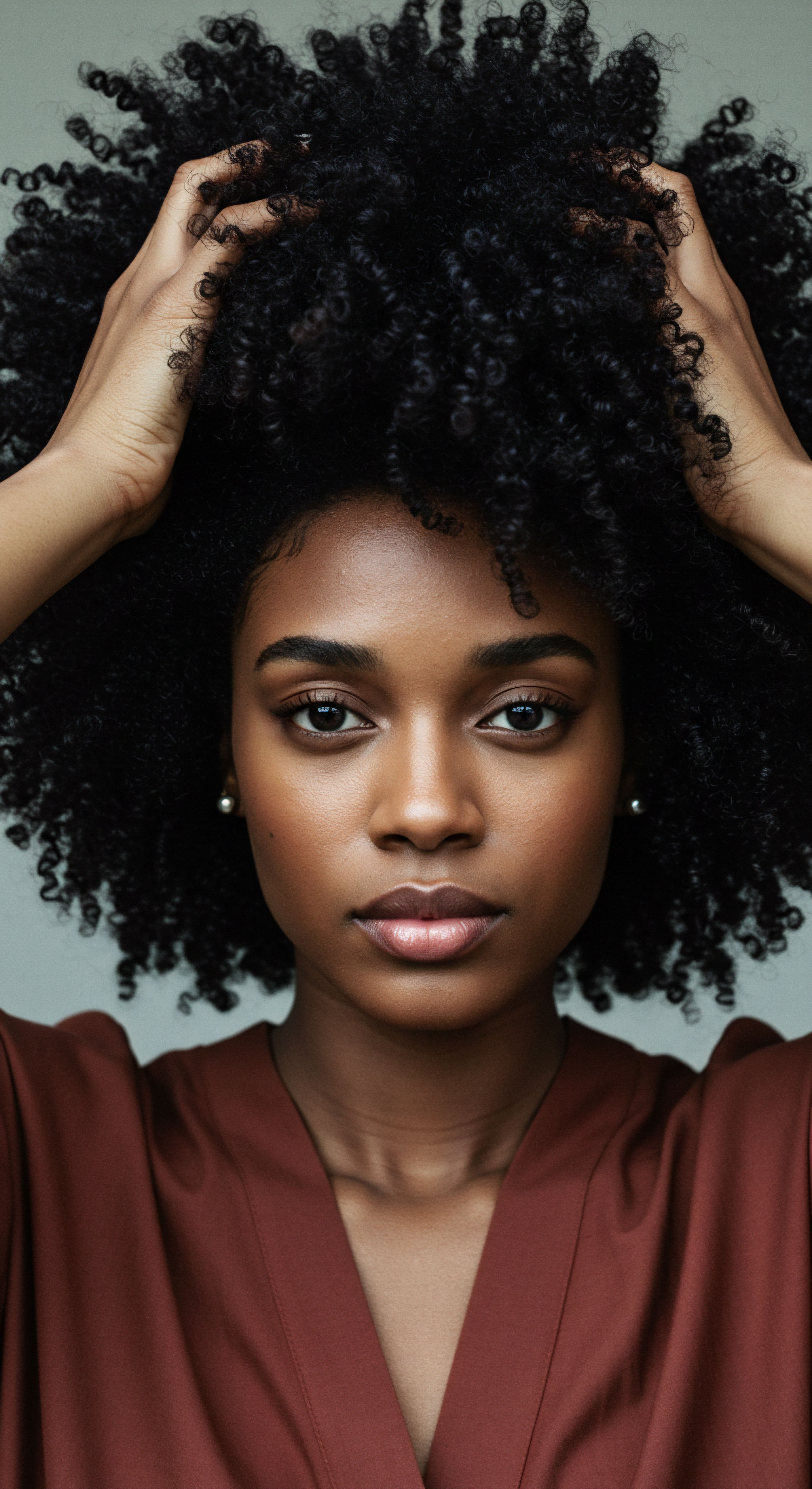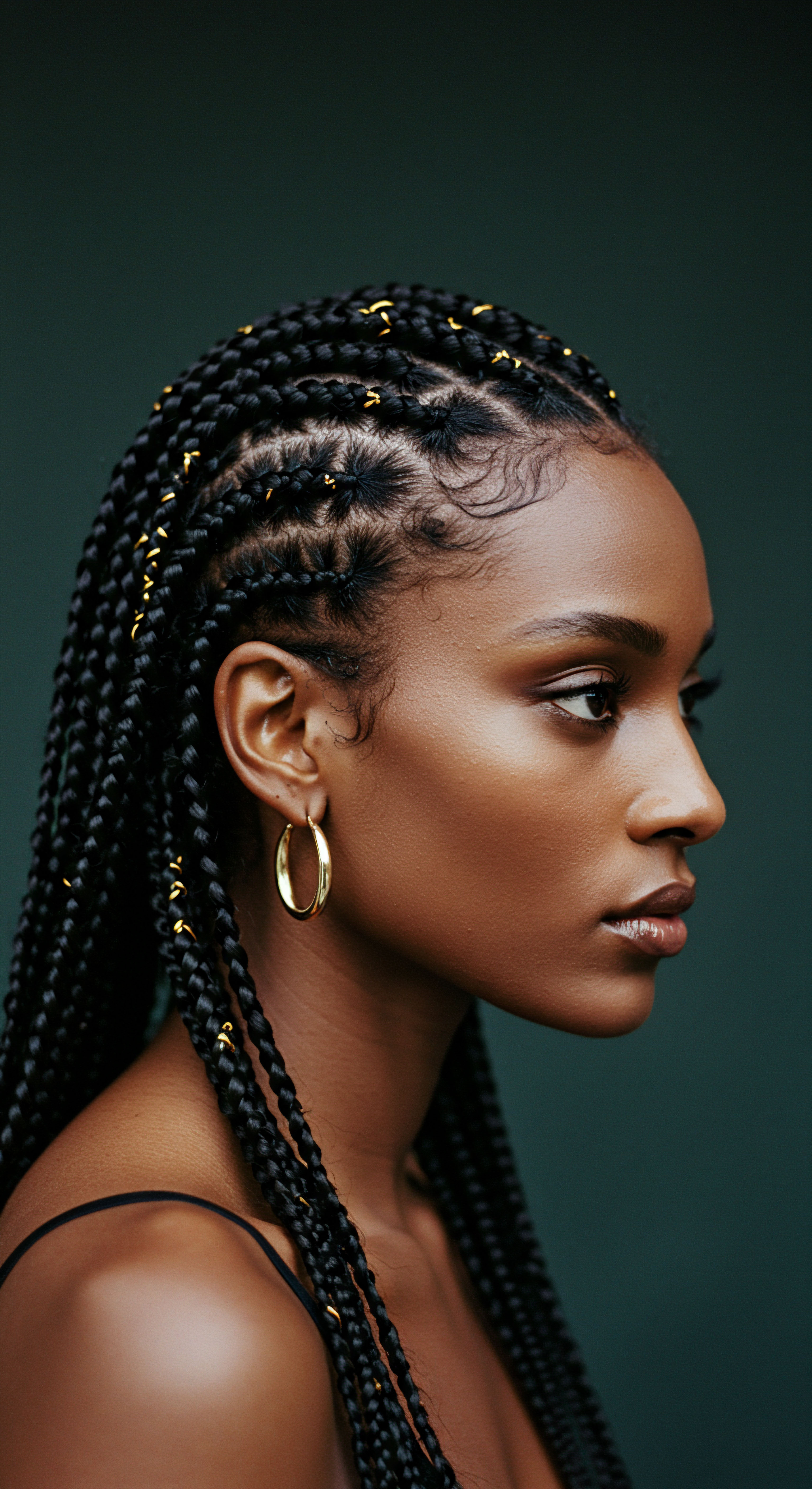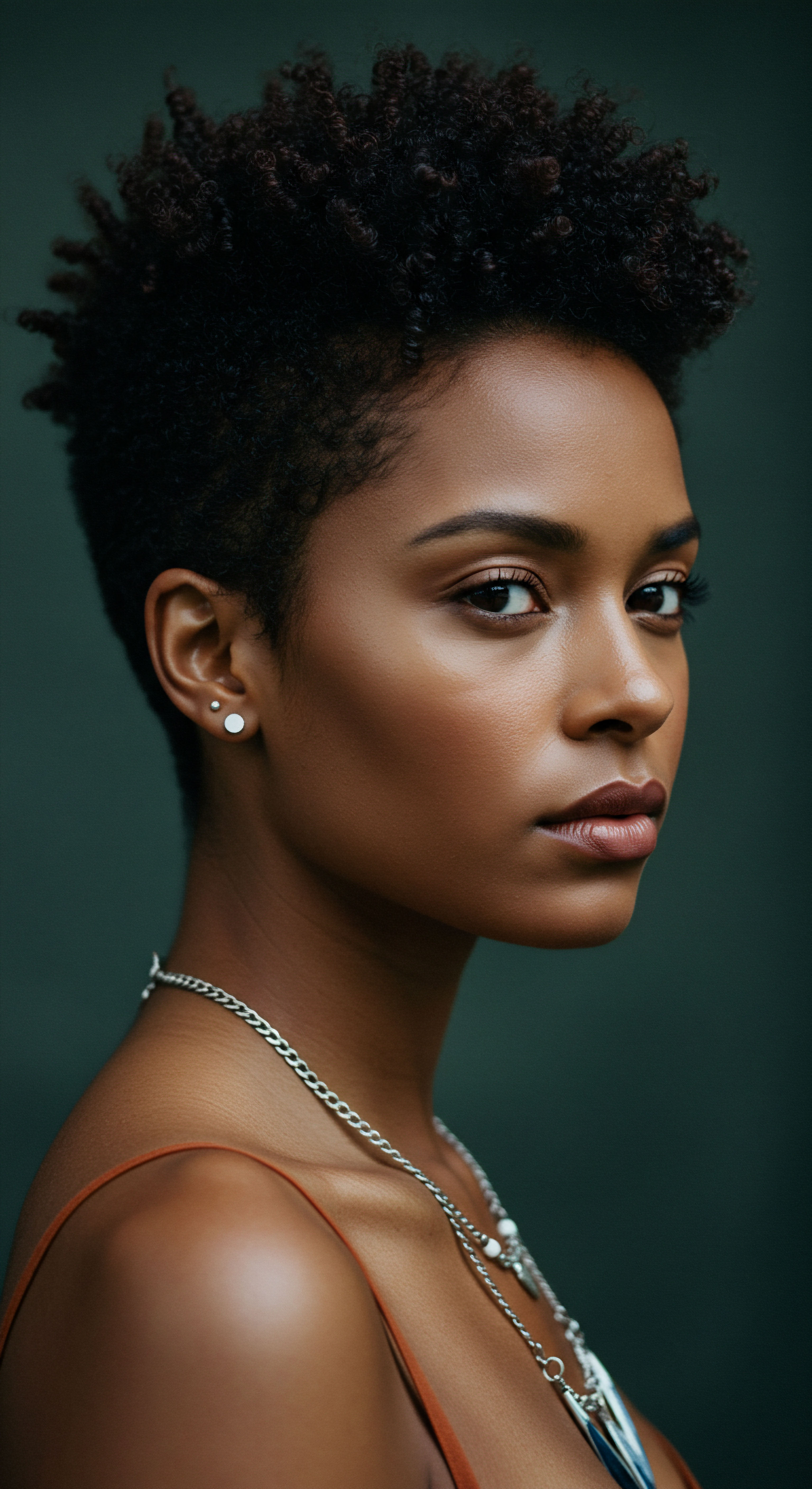
Fundamentals
Trichology, at its gentle heart, represents the scientific study of human hair and scalp health. The designation itself originates from the Greek word ‘trikhos,’ signifying hair, paired with ‘ology,’ denoting a field of study. This specialized area, sometimes viewed as a bridge between the aesthetic realm of cosmetology and the medical precision of dermatology, delves into the complexities of hair structure, its natural growth cycles, and the various conditions or disorders that might affect both the strands and the skin beneath.
A trichologist, then, is a dedicated professional, trained to identify, understand, and provide guidance for a wide array of concerns, ranging from hair loss and breakage to scalp irritations and structural anomalies. Their approach is inherently holistic, acknowledging that the vitality of one’s hair often mirrors the overall well-being of the individual, considering factors like diet, lifestyle, and even emotional states.
For those with textured hair, particularly within Black and mixed-race communities, this foundational understanding of trichology holds a distinct and profound significance. The unique architecture of highly coiled and curly hair, characterized by its elliptical cross-section and the angle at which it emerges from the scalp, presents specific care considerations and vulnerabilities. Therefore, grasping the basic tenets of trichology provides a guiding light, offering a framework for appreciating the inherent beauty and resilience of these hair types while also recognizing their particular needs. This foundational knowledge empowers individuals to move beyond anecdotal remedies, fostering a deeper, more informed relationship with their crowns.

The Roothea Perspective on Basic Hair Science
Roothea believes that understanding the fundamental biological components of hair provides a powerful starting point for anyone, especially those navigating the specific requirements of textured hair. Hair, at its simplest, is a protein filament, primarily composed of keratin. This protein is arranged in a sophisticated manner, forming three main layers ❉ the cuticle, cortex, and medulla. The outermost layer, the Cuticle, consists of overlapping, scale-like cells that protect the inner structure.
The Cortex, the middle layer, gives hair its strength, elasticity, and color, while the innermost Medulla, often absent in finer hair types, is a soft, central core. The shape of the hair follicle itself plays a determining role in the curl pattern; an oval-shaped follicle yields curly hair, while a circular one produces straight strands.
Recognizing these basic elements allows us to appreciate why textured hair, with its unique bends and coils, often experiences moisture challenges. The twists and turns along the hair shaft make it harder for natural oils, or sebum, to travel from the scalp down the entire length of the strand, contributing to dryness. This inherent dryness, combined with the structural points where the hair bends, can increase its susceptibility to breakage.
Trichology offers a foundational scientific understanding of hair and scalp health, crucial for appreciating the distinct needs of textured hair.
Consider the seemingly simple act of washing hair. For textured hair, this ritual is often approached with a heightened awareness of preserving moisture and minimizing manipulation that could lead to damage. The science of trichology helps explain why certain products or techniques might be more beneficial. For example, products rich in conditioning agents and emollients are often recommended to replenish moisture and improve pliability, counteracting the natural tendencies toward dryness.

Intermediate
Stepping into an intermediate understanding of Trichology Research moves beyond simple definitions, inviting a deeper examination of its practical applications and how its findings directly influence daily hair care practices, particularly for textured hair. This level of inquiry involves recognizing the common hair and scalp concerns that trichologists address, and appreciating the diagnostic methods they employ to arrive at precise solutions. It involves comprehending that the science of hair is not static, but continually evolving, with new research shedding light on the intricate biological and environmental factors that shape hair health.

Common Concerns and Diagnostic Pathways
Trichology Research provides the framework for understanding a spectrum of hair and scalp issues. These often include various forms of hair loss, such as androgenetic alopecia, telogen effluvium, and alopecia areata, alongside conditions like dandruff, seborrheic dermatitis, and psoriasis. For individuals with textured hair, certain conditions, like Traction Alopecia and Central Centrifugal Cicatricial Alopecia (CCCA), are particularly prevalent due to a complex interplay of genetic predispositions, structural characteristics, and traditional styling practices.
A trichologist’s diagnostic process typically involves a thorough consultation, examining the scalp and hair, and often utilizing specialized tools like a dermatoscope (trichoscopy) to magnify the scalp and hair follicles. This visual analysis helps identify specific patterns of hair loss, scalp inflammation, or structural abnormalities in the hair shaft. For instance, trichoscopy can reveal subtle signs of damage or specific follicular patterns indicative of conditions common in textured hair, allowing for early intervention.
| Population Group African American Women |
| Reported Prevalence ~48% (hair loss on crown/top, mostly TA) |
| Source / Context Boston University Slone Epidemiology Center study of ~6,000 women |
| Population Group Women of African Descent |
| Reported Prevalence One-third (general estimate) |
| Source / Context Clinical, Cosmetic and Investigational Dermatology journal |
| Population Group African Schoolgirls (6-21 years) |
| Reported Prevalence 17.1% |
| Source / Context Population studies in Africa |
| Population Group African Women (18-86 years) |
| Reported Prevalence 31.7% |
| Source / Context Population studies in Africa |
| Population Group These figures highlight the significant impact of traction alopecia within African and African diaspora communities. |

The Interplay of Culture and Science in Textured Hair Care
The intermediate level of Trichology Research for textured hair also acknowledges the profound cultural dimensions of hair care. Hair holds immense cultural significance within Black communities, serving as a marker of identity, status, and self-expression. Historically, hair care practices were deeply intertwined with ancestral knowledge and community rituals. However, societal pressures and Eurocentric beauty standards have often led to practices, such as excessive chemical straightening or tight protective styles, that can compromise hair health.
This is where Trichology Research offers a vital intervention. It does not dismiss traditional practices but rather seeks to understand their scientific implications, providing guidance on how to adapt them to promote health. For instance, while tight braiding or extensions can lead to traction alopecia, the research also explores how these styles can be modified to reduce tension and protect the hair follicle. The focus shifts towards understanding the biomechanics of textured hair – its unique curl patterns, its tendency for dryness, and its inherent fragility compared to straight hair – to develop care regimens that truly support its well-being.
Intermediate trichology explores specific hair and scalp concerns, applying diagnostic methods and acknowledging the deep cultural connections of textured hair care.
Consider the prevalent issue of hair breakage. Studies indicate that African hair is more prone to developing knots, longitudinal fissures, and splits along the hair shaft. This is due to its complex structure, including variations in cortical cell distribution and the highly coiled nature, which can lead to areas of weakness. Understanding these microscopic realities allows trichologists to recommend specific detangling methods, conditioning routines, and product choices that minimize mechanical stress, thereby preserving the integrity of the hair strand.
Roothea encourages an approach that honors cultural heritage while integrating scientific knowledge. This means understanding that a protective style, for example, is not merely a fashion choice but a practice with historical roots and potential physiological consequences. By marrying cultural wisdom with scientific understanding, individuals can make choices that both celebrate their heritage and safeguard their hair’s vitality.

Advanced
At its most sophisticated stratum, the definition and meaning of Trichology Research extend into a highly specialized domain, one that demands a comprehensive understanding of hair biology, pathology, and the complex interplay of genetic, environmental, and psychosocial factors. For textured hair, particularly within the Black and mixed-race diaspora, this advanced exploration is not merely academic; it is a critical endeavor to rectify historical oversights and forge pathways toward genuinely inclusive and effective hair wellness. This level of inquiry necessitates a deep dive into the molecular underpinnings of hair morphology, the specific pathologies disproportionately affecting these hair types, and the profound cultural and psychological dimensions that shape hair experiences.

Microscopic Architecture and Biomechanical Vulnerabilities
The advanced study of Trichology Research begins with a precise delineation of the unique structural attributes of highly coiled hair. Unlike the generally circular cross-section of straight hair, Afro-textured hair typically presents an elliptical or flattened cross-section, with variations in diameter along the shaft. This inherent helical geometry means that the hair shaft undergoes multiple twists and turns as it grows, creating points of stress and reduced mechanical strength. The cuticle, the protective outer layer, is often thinner at these curves, leaving the cortex more exposed to external aggressors.
Moreover, the distribution of cortical cells (orthocortical, paracortical, and mesocortical) within the hair fiber can be asymmetrical in textured hair, contributing to its curl pattern and potentially its susceptibility to breakage. The challenge of sebum distribution, where natural scalp oils struggle to descend the entire length of a highly coiled strand, results in chronic dryness, which in turn diminishes elasticity and increases fragility. This predisposition to dryness is a key area of focus in advanced trichology, driving research into humectants, emollients, and occlusives that can effectively penetrate and seal moisture within the hair fiber.
- Hair Follicle Morphology ❉ An oval or asymmetrical hair follicle shape directly influences the degree of curl, with a more pronounced oval leading to tighter coils.
- Cuticle Integrity ❉ The tightly packed, smaller cuticle scales on curlier hair may make it harder for moisture to be retained, despite having a higher overall lipid content.
- Tensile Strength ❉ Textured hair generally possesses less tensile strength and reaches its breaking point earlier than other hair types, a critical factor for mechanical stress.

Pathologies of Particular Concern ❉ Beyond the Cosmetic
Advanced Trichology Research rigorously examines hair and scalp conditions that disproportionately affect individuals with textured hair, moving beyond superficial symptoms to uncover underlying etiologies. Conditions such as Traction Alopecia (TA) and Central Centrifugal Cicatricial Alopecia (CCCA) are not merely cosmetic concerns; they represent complex dermatological challenges with significant psychosocial impacts. TA, for instance, results from chronic tension on the hair follicles, often linked to tight braiding, weaves, or chemical relaxers. While often reversible in early stages, prolonged tension can lead to permanent follicular damage and scarring.
CCCA, a scarring alopecia, is recognized as the most common cause of hair loss in women of African descent. Its pathogenesis is believed to involve genetic predispositions combined with external factors like chemical treatments and excessive heat. Advanced research seeks to identify specific genetic markers, understand the inflammatory pathways involved, and develop targeted therapeutic interventions beyond general anti-inflammatories. The focus is on interrupting the destructive process that leads to permanent hair loss and providing effective management strategies.
Advanced Trichology Research provides a sophisticated understanding of hair biology, cultural context, and specific pathologies affecting textured hair, guiding precise, culturally attuned care.
Consider the often-overlooked psychological and social ramifications of hair loss within Black communities. Hair is not merely an adornment; it is a profound marker of identity, cultural heritage, and self-worth. The experience of hair loss, whether from traction alopecia or CCCA, can lead to internalized racism, anxiety, hypervigilance about appearance, and even depression. A 2019 study by Boston University’s Slone Epidemiology Center, examining nearly 6,000 women of African descent, found that almost 48% reported hair loss on the crown or top of the head, predominantly caused by traction alopecia.
This striking statistic underscores a pervasive and often silently endured challenge, revealing that the problem extends far beyond individual styling choices, touching upon societal beauty standards and access to culturally competent hair care advice. The emotional impact is so profound that participants in TRIYBE research workshops shared feelings of losing a part of their identity when experiencing hair loss, with one individual articulating, “When I lost my hair, I didn’t just lose strands… I lost a part of my identity. People stopped recognizing me, but worse, I stopped recognizing myself.” This sentiment highlights the critical need for trichological interventions that are not only scientifically sound but also deeply empathetic and culturally informed, addressing both the physical and psychological burdens.

Innovations and Future Directions in Textured Hair Research
The advanced frontier of Trichology Research is actively addressing the historical gaps in scientific understanding concerning textured hair. For decades, much of the research in hair science disproportionately focused on straight hair types, leading to a limited comprehension of the unique properties and needs of curly and coily hair. This disparity has prompted a renewed commitment to specialized investigations.
One significant area of advancement involves genomic studies. Researchers are working to identify specific genetic differences between Afro-textured hair and other hair types, understanding how gene polymorphisms influence hair growth rate, diameter, and mechanical properties. For instance, studies are examining genes like Trichohyalin (TCHH), crucial for keratin filament cross-linking and mechanical strength, and PEX14, which plays a role in hair shape. This genetic mapping promises to unlock personalized hair care solutions, moving beyond broad categorizations to highly tailored regimens based on an individual’s unique genetic blueprint.
Another cutting-edge area involves biomechanical analysis. Scientists are using advanced imaging and testing methods to precisely measure the tensile strength, elasticity, and breakage patterns of textured hair under various conditions. This includes simulating real-life chemical and physical treatments, such as bleaching and heat styling, to understand their combined effects on hair porosity and structural integrity. Such research is crucial for developing formulations that not only repair existing damage but also offer robust protection against future stressors, specifically formulated for the biomechanical challenges of highly coiled hair.
- Molecular Structure ❉ Understanding the intricate arrangement of keratin proteins and disulfide bonds provides insight into the inherent strength and vulnerability of textured hair.
- Environmental Adaptations ❉ Research explores how specific hair types may have evolved as adaptations to various climates, with tightly coiled hair potentially offering superior scalp protection in hot environments.
- Product Formulation ❉ Advanced cosmetic chemistry leverages trichological findings to create products that address specific challenges like moisture retention, detangling, and scalp health for textured hair.
The collaboration between cosmetic scientists, dermatologists, and trichologists is essential in this advanced phase. For example, the development of specialized shampoos and conditioners for textured hair, designed to optimize moisture retention and reduce friction during washing, directly stems from these research findings. The goal is to move towards a future where hair care is not a reactive measure against damage but a proactive strategy rooted in deep scientific understanding and cultural appreciation, ensuring that textured hair is celebrated and sustained in its healthiest form.

Reflection
Our journey through the landscape of Trichology Research reveals a discipline far richer and more resonant than a mere study of strands. It unveils a profound connection between scientific inquiry and lived experience, particularly for those whose heritage graces them with the beautiful complexity of textured hair. The pursuit of knowledge in this field is not a detached academic exercise; it is an act of reclamation, an honoring of identity, and a gentle invitation to nurture what has often been misunderstood or even marginalized.
As we consider the intricate spirals and resilient coils that define so many, we recognize that each scientific discovery, each nuanced understanding of a hair fiber’s resilience or vulnerability, becomes a whisper of wisdom, guiding us toward more compassionate and effective care. This dedication to understanding hair, not just as a biological entity but as a cultural touchstone, ensures that Roothea remains a beacon of informed affection, fostering a deeper, more serene relationship with every unique crown.

References
- Dawber, R.P.R. & Van Neste, D. (1995). Hair and Scalp Disorders. Blackwell Science.
- McMichael, A. J. & Hordinsky, M. K. (Eds.). (2014). Hair and Scalp Diseases ❉ Medical, Surgical, and Cosmetic Treatments (2nd ed.). CRC Press.
- Chandrashekar, B. S. & Madura, C. (2018). IADVL Textbook of Trichology. Jaypee Brothers Medical Publishers.
- Sinclair, R. (2013). Fast Facts ❉ Disorders of the Hair and Scalp (2nd ed.). Karger Publishers.
- Ray, D. (2016). What Is GOOD HAIR? ❉ A Simplified Trichology Manual. CreateSpace Independent Publishing Platform.
- Rodney, P. R. & Van Neste, D. (2004). Hair and Scalp Disorders ❉ The Facts. Oxford University Press.
- Trueb, R. M. (Ed.). (2009). Aging Hair. Springer.
- Tosti, A. (2007). Hair and Scalp Diseases ❉ A Practical Guide. Informa Healthcare.
- Gaines, S. & Salsbury, J. (2025). The Science of Curly Hair Typing. CurlsBot.
- Maharaj, C. (2025). Beyond the roots ❉ exploring the link between black hair and mental health. TRIYBE.
- Alexis, A. F. & McMichael, A. J. (Eds.). (2011). Hair and Scalp Diseases in Ethnic Populations. CRC Press.
- Kamath, Y. K. et al. (1984). Fracture patterns in Walker Type 4 hair. Journal of the Society of Cosmetic Chemists, 35(6), 333-340.
- Malinauskyte, E. et al. (2020). The effects of protein treatments on breakage in textured hair. International Journal of Cosmetic Science, 42(4), 380-388.
- Dinh, Q. & Sinclair, R. (2007). Female pattern hair loss ❉ current treatment concepts. Clinical, Cosmetic and Investigational Dermatology, 1, 189–199.
- Miteva, M. & Tosti, A. (2013). Dermoscopy of hair and scalp. Journal of the American Academy of Dermatology, 69(5), 794-802.